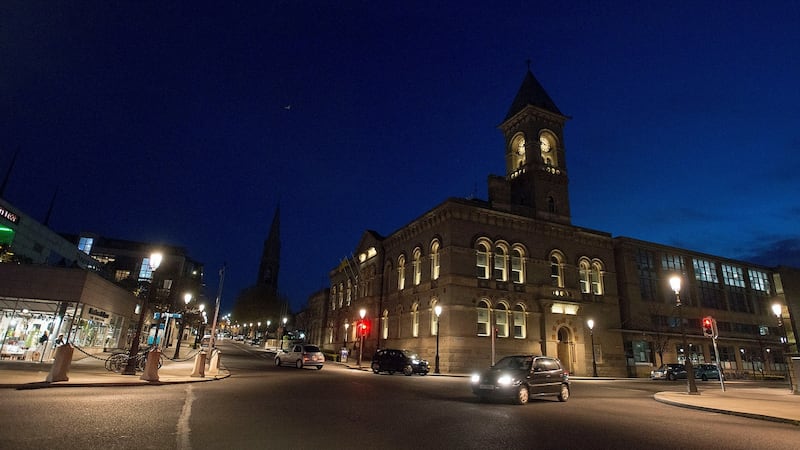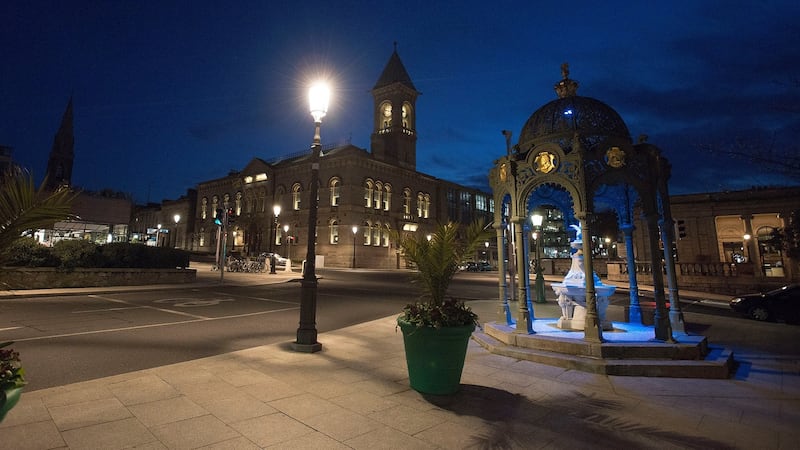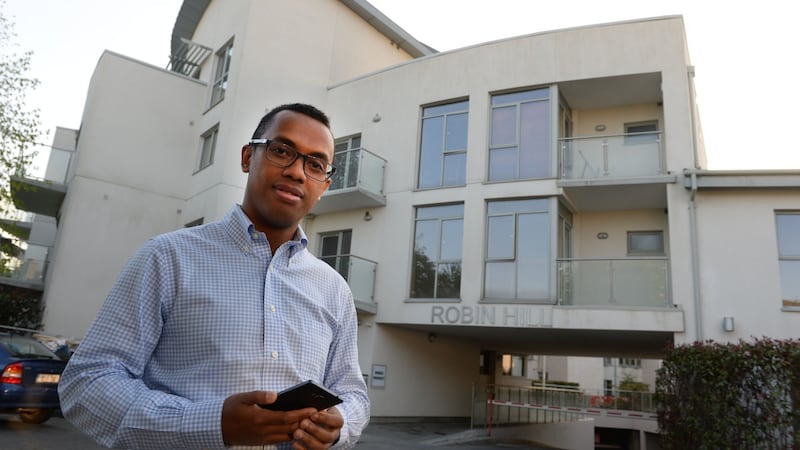William Tutty strolls along George’s Street Upper in Dún Laoghaire with his dog, Daisy. He carries a bag that contains her feeding bowl, his cigarettes and some of his belongings.
Homeless for almost two years, the 47-year-old is heading to catch a train to Dublin city centre, for another night at the Brú Aimsir hostel, on Thomas Street. He would prefer his tent and a favourite quiet spot under bushes beside the nearby beach in Killiney, but the nights have been too cold.
“I don’t like it, but I will just have to stick it out,” he says. “It is very noisy. I like to keep to myself, and it is hard to keep to myself, because there are so many people in it. I just like to be on my own. Hopefully things will turn around.”

Tutty is standing across the road from Adelphi Manor, a residential block that is being marketed as “spacious apartments and penthouses in the heart of Dún Laoghaire”. He says he is shocked at the increased number of people sleeping rough as a result of the housing crisis and soaring rents. He has been on Dún Laoghaire-Rathdown County Council’s housing waiting list for almost 12 years.
“You see homeless all over the place. Dún Laoghaire is not bad, but in the city they are all over the place. Every corner you turn you always see someone,” he says.
On the surface Dún Laoghaire’s streets reflect the town’s status as one of the country’s wealthiest areas. At the next corner along from where I bump into Tutty is the local branch of Sherry FitzGerald. In its window the cheapest house for sale is a terraced two-bedroom cottage in Glasthule with an asking price of €345,000; the most expensive is a six-bedroom Victorian house on the market for €1.85 million.

The Dún Laoghaire-Rathdown area is a place of stark contrasts. Beyond the multimillion-euro Georgian terrace and seafront homes of Killiney and Dalkey are the council estates of Ballybrack, Rathsallagh and Monkstown Farm. The average value of a three-bedroom semi-detached house in Dún Laoghaire rose by 61 per cent, to €506,000, in the five years to 2017. Prices are even higher in the neighbouring areas of Sandycove and Monkstown.
Steven Manek, Sherry FitzGerald’s sales director for the Dublin region, says that demand is strong in the first-time-buyer market for properties with asking prices under €500,000, as well as at the higher end of the market, but that housing is in chronically short supply.
“The stock is very, very low, and as a result you have really strong bidding interest in areas of Glasthule and Sandycove. Dún Laoghaire and its immediate suburbs are very popular with buyers again.”
There are other signs of affluence. The area has the third-highest number of owner-occupiers without a loan or mortgage in the country, according to the 2016 census, and the highest percentage of households – 86 per cent – with broadband internet.
The social-housing needs could, on paper, be met by filling vacant properties: the census recorded 5,146 vacant properties in Dún Laoghaire. But the solution is not so simple.
There are signs of distress, too. There are 5,097 “households” – mostly families – waiting for social housing from the council (out of 91,600 on local authority housing lists nationally). Just 290 social-housing units were added in Dún Laoghaire last year. At this rate of construction it would take almost 18 years to clear this list.
The social-housing needs could, on paper, be met by filling vacant properties: the census recorded 5,146 vacant properties in Dún Laoghaire. But the solution is not so simple.
“When I talk to colleagues in other local authorities the perception is the leafy, wealthy suburbs of Dún Laoghaire when you are looking out on Vico Road or Sandycove or Monkstown,” says Cormac Devlin, a Fianna Fáil councillor, who is also Cathaoirleach of Dún Laoghaire-Rathdown council. “Within those areas, and others, there are people who are struggling to make ends meet – and they need help.”
The increased cost of buying or renting property here, which can be at least 20 per cent higher than in other parts of the country, means that the divide between rich and poor is more pronounced. The shortage of available accommodation – be it social housing or affordable private-rental property – and green spaces for new-home developments means the squeeze is more keenly felt.
“For those in housing difficulty, or who have less money, it is worse for them, because housing is so far out of their reach but their welfare payments are the same as anyone else in the country. Rents and property prices are in the stratosphere,” says Richard Boyd Barrett, the People Before Profit TD for Dún Laoghaire.
He describes it as a form of social cleansing: an accelerated process of gentrification that is preventing children of working-class people and the less well-off from living where their parents grew up.

Couch surfing
Both the supply and the affordability of housing, either to buy or rent, have historically been very tight in Dún Laoghaire. Even at the height of the economic crisis Dún Laoghaire-Rathdown had the lowest unemployment in the country, at 11.2 per cent, compared with the national peak of 15.1 per cent. It has the lowest proportion of mortgaged households where the head of the household is out of work.
One really awful scenario I am faced with every week in my clinic is people who have never had drug or addiction problems becoming homeless, and the only accommodation they are being offered is where they are sharing with people with drug and addiction problems,"
This has insulated the area somewhat. Rents did not fall as sharply here as they did elsewhere during the crisis, and they’re rocketing now. The census found that rent increases in the area over the past five years were the second highest in the country, at 26.2 per cent.
Tenants have been forced back into living with parents, into couchsurfing with relatives or friends, or, in severe cases, into emergency accommodation and traumatic situations.
“One really awful scenario I am faced with every week in my clinic is people who have never had drug or addiction problems becoming homeless, and the only accommodation they are being offered is where they are sharing with people with drug and addiction problems,” Boyd Barrett says.
The State long ago gave up large-scale social-housing construction; it relies instead on the private sector. This may make sense in theory, but in a dysfunctional market landlords can drive up rents as growing numbers of would-be tenants fight over a dwindling supply of properties.
Tenants relying on subsidies such as the housing assistance payment, or HAP – one option held up by the Government as a solution to the crisis – can find themselves at the back of the queue.

Anna Byrne, a 30-year-old single mother, has been sleeping on a bedroom floor in her father’s council house, in Sallynoggin, next to her four-year-old son and two-year-old daughter since she was forced to leave her rented home, when her landlord sold the property, in December 2013. Her niece sleeps in a bed in the same room; her sick father and nephew each have their own room in the house.
“I am literally in an overcrowded house. I don’t need to be lying on a wooden floor with blankets over us. I need a home,” Byrne says.
She has been on the waiting list for social housing with Dún Laoghaire-Rathdown for five years; she has also been unable to find a landlord who will accept her as a tenant under the HAP scheme.
“It is just ridiculous. I have been trying to look for places on the HAP, and nobody wants to know,” she says. “I went to the council, and they wanted to put me in a hotel in Finglas. I don’t even know where Finglas is. I have been fighting for a home, but nobody will listen to me. The council says: ‘You have a room over your head and water coming out of your taps.’ It’s just insane.”

Minister for Housing Simon Coveney plans to address the crisis by building 130,000 social-housing units by 2020, including 83,000 through HAP tenancies, where a local authority pays landlords rent directly and the tenant pays a partial rent to the local authority based on income.
Boyd Barrett argues that the demand for rental homes is so great that HAP tenants, if they manage to secure a place, will end up in the worst quality accommodation. If tenants complain, the council will be reluctant to act for fear of reducing the number of rental properties available under the HAP.
“We are facing a return to tenement conditions,” he claims. “It is already happening with people being crammed into family homes in large numbers. But the other reason it is going to happen is that [in future] the only landlords who will sign arrangements with local authorities are those renting out chronic, dilapidated properties.”
Frustrated by the reliance on private-sector solutions, Boyd Barrett recently invited 20 or so people affected by the crisis to the Dáil gallery to help make his case for more action to Taoiseach Enda Kenny during a debate last month.
“It was a very direct attempt to puncture the fantasy of their projections,” he says.
‘I don’t need luxury’
For those in the Dáil gallery that day the solutions on offer are not working.
Siobhán, who does not want to give her real name, is a 30-year-old single mother who has been living from week to week in a hotel in Dún Laoghaire so that her four-year-old daughter can continue going to school nearby.
The council suggested that she take a room in a hostel in the city, but when she inspected it she found used needles outside the window. She estimates that she has viewed 60 apartments, but landlords do not want to accept the HAP scheme “because they don’t understand it”.
Such is the demand that most apartments have been viewed by dozens of others by the time Siobhán sees them. “If I can get a one-bedroom I would take it. I don’t need luxury or fanciness or a big two-bedroom. I just need somewhere where I can put my daughter to sleep at night that is safe,” she says.
Eamon and Sarah Smith, who are 31 and 29, were waiting for a council house in Dún Laoghaire for nine years. They moved on to South Dublin County Council, and a house in Tallaght, because before March 1st the HAP scheme was not available in Dún Laoghaire. With four children under nine, they are expecting their fifth child. They have been given notice by their landlord that he intends to sell their house; they have to find another landlord who will accept their HAP tenancy by June 23rd. They have applied for 56 houses in a month but secured nothing.
“Most letting agents are email only. We learned early on from advice not to mention HAP until you go face to face with the landlord. If you mention HAP in the email your email gets lost,” Eamon says. “The HAP scheme just doesn’t work. It is not a solution to the housing problem. It is putting too much pressure on the tenants themselves to find a new house.”
My little one has to have a room. She is basically kicking me in her sleep. She has asthma as well, so everything in the room is clogging it up. It is too much for her."
Leslie, who is 31, punched a bedroom door of his rental house in Rathfarnham in frustration when he and his wife, Gemma, were told by Dún Laoghaire-Rathdown County Council that, after seven years on a waiting list, they were no longer eligible for social housing. Gemma had taken on extra hours at work, covering for a colleague on maternity leave in her retail job. This put them €1,600 over the council’s eligibility income threshold of €38,500 a year for a couple and two children.
“I was in shock for a month and a half. It is not a nice feeling that no one is going to help,” says Gemma, who is also 31. “If we take the pay rise then we are stuck with the council. If we don’t take a pay rise we can’t make ends meet.”

Cathríona, a 33-year-old part-time hairdresser, has been sharing a bed with her three-year-old daughter for two years in a boxroom in her mother’s home, in Monkstown Farm. A council official inspected the house and suggested that she move into another bedroom with her 26-year-old sister and that they put another bed into the boxroom for her daughter and her sister’s child.
“How can you fit another bed in that tiny room?” she says.
She has been approved for an HAP tenancy, and she has contacted five places seeking accommodation, but none of them has returned her call.
“It is a nightmare,” she says. “My little one has to have a room. She is basically kicking me in her sleep. She has asthma as well, so everything in the room is clogging it up. It is too much for her.”
Tremayne Light was living in his car in Killiney Hill car park for four weeks before being admitted to hospital last month. The 53-year-old has hepatitis C, has had a liver transplant, uses a wheelchair and is awaiting further surgery. A social worker at the hospital is trying to find him a long-term medical-care unit through Dún Laoghaire-Rathdown council.
“In 2017, in Ireland, am I hopeful of getting a friendly place to stay that’s warm, dry and safe,” he says.
The sale of apartment blocks to so-called vulture funds by the National Asset Management Agency, or Nama, the State agency set up to buy property loans from banks to repair the sector, is not helping the situation.
A handful of tenants living in Robin Hill, a block of 51 apartments in nearby Sandyford, have received eviction notices from a property company acting for the receiver, Grant Thornton.
They have been told that the receiver intends to sell the building. Nama sold the block to the US investment fund Cerberus last year with a bundle of other assets in a portfolio sale called Project Gem.
Under legislation and the so-called Tyrrelstown amendment, passed last year with the aim of giving tenants greater security of tenure and rent certainty, funds are limited to evicting no more than 10 tenancies at once and to raising rents by no more than 4 per cent in areas deemed to be “rent pressure zones”.
There's no prospect of being able to buy somewhere with the amount you have to save. At 32 years of age, it looks like I will have to go back to my parents."
Cerberus is staying within the law by issuing no more than 10 eviction notices to tenants of Robin Hill. But with 10 more vacancies the fund will secure a higher price for the block.
“It is a huge concern,” says Robert Scott, who received an eviction notice and now has to leave by June 25th. “There’s no prospect of being able to buy somewhere with the amount you have to save. At 32 years of age, it looks like I will have to go back to my parents.”
Scott has been paying €1,050 a month for a two-bedroom apartment since 2013; a neighbour who moved in next door last year is paying €1,600 for the same type of apartment.

Naly Rafamantanantsoa, an IT engineer from Madagascar, has received an eviction notice, too; he is struggling to find a new home without accepting a huge hike in rent. “There are not many one-bedrooms in the area, but also, if there are few in the area, they are €1,600,” he says.
“What I don’t understand is that they are going to move us out and rent it to someone else. So where are we going to go?”
Grant Thornton declined to comment on what it or Cerberus plans for Robin Hill. Cerberus had not commented on Robin Hill by the time of publication. The US company typically doesn’t comment on specific cases.
A Belfast-based spokesman for the US firm, however, referred to past comments made by Cerberus to a Northern Ireland Assembly committee about how it operates, saying that it acts “within the framework of local laws” and that it tries to “maintain positive relationships with borrowers, other local stakeholders and the communities in which they live and work.”
One day last month Boyd Barrett checked what was available in the Dublin rental market. Of 1,155 available to rent in Dublin on the property website Daft.ie, there were just 28 three-bedroom properties for rent at less than €1,500 a month and just 55 for less than €1,800.
Nama straight jacket
The Dún Laoghaire TD believes that the Government could have solved the housing crisis with Nama by changing the agency’s mandate from a commercial to a social remit and by directing it to provide more social housing.
“It was a political decision by Fine Gael, and it was a very misguided decision that produced the crisis that we have now,” he says.
Nama’s response? It’s complicated. The agency’s purpose is to recover as much money as it can from the assets it acquired and then return as big a profit as possible to the State, which, if politicians so desire, could then be used for social housing.
The agency is expecting to return a profit of €2.3 billion to the State. Nama’s view is that even if it wanted to sell properties below the market value for social housing, it cannot: it owns loans, not properties, and debtors – the developers – could sue if the maximum market amount were not achieved, as this type of sale would not reduce their debts by as much as a sale on the open market would.
“The commercial straitjacket is a good idea for someone who has been given a load of taxpayers’ money to buy loans, and it is tasked with getting the money back for the taxpayers,” a spokesman for the Department of Finance says. “Even if you remove it, Nama doesn’t have access to the kind of properties that people think Nama has access to.”
The State can't build all those houses. It is a process that takes time. We are going through everything that should have been done 10 years ago. We are still cleaning up that mess."
Despite its commercial remit Nama has delivered 2,378 residential properties for social housing. This includes 254 units in Dún Laoghaire-Rathdown, among them 124 in the Honeypark development, on the site of the old Dún Laoghaire golf club, built by Cosgrave Brothers developers with funding from Nama.
These projects all help, but the recent construction inactivity has left a shortage of housing that the Government says will take a long time to address.
Coveney’s “Rebuilding Ireland” plan proposes offering more than 800 publicly owned sites around the State to private developers and housing associations for the provision of 50,000 homes. His map of the plan shows 24 council sites in Dún Laoghaire-Rathdown, covering almost 44 hectares (109 acres), the equivalent of about five St Stephen’s Greens, in Dublin city centre.
“We are not looking to hand land to private developers, but we do need builders to build houses for us,” Maria Bailey, the Fine Gael TD for Dún Laoghaire, says. “The State can’t build all those houses. It is a process that takes time. We are going through everything that should have been done 10 years ago. We are still cleaning up that mess.”
To address undersupply the council points to what are effectively three new towns being planned: Cherrywood, Kiltiernan-Glenamuck and Shanganagh-Woodbrook. They will provide 12,300 homes, including at least 1,230 social- and affordable-housing units, under the requirements of the Urban Regeneration and Housing Act.
Bailey notes that Dún Laoghaire-Rathdown received the most of any council – €40 million of €226 million – from a Government fund unveiled in March to make privately owned sites ready for large housing developments by funding roads, water schemes and sewers.
Construction work has started on another 302 social units in the council’s area, and a further 186 are in the planning stage, with work being done with approved housing bodies to deliver another 207.
In addition the council cites the HAP scheme as part of the solution, although just 19 tenancies have been signed under the scheme in Dún Laoghaire in the past two months.
“The general housing-supply issue is part of a wider problem in the housing sector,” the council’s director of housing, Catherine Keenan, says. “Addressing any one element of that problem, be it the construction sector, the financial sector or the planning sector, will not in itself provide an all-encompassing solution.”
This multifaceted fix is not coming fast enough for some.
Sitting in the kitchen of his rented house in Tallaght, Eamon Smith says that his wife’s grandmother died last week and that her council house in Dún Laoghaire, the family home for 48 years, will be boarded up. It will then take four or five months to be refurbished for another applicant.
The couple went to the council to ask if they and their four children could move in temporarily, in response to their June 23rd eviction. But by moving to the HAP scheme they were taken off the housing list after their nine-year wait, because their housing “need” was considered met. The couple can apply to join a transfer list.
“You’d think that nine years would be enough,” he says. “Someone had come in the previous day to the council, and he was 20 years on the housing list.
“Nine years isn’t a long time.”











